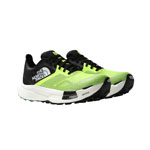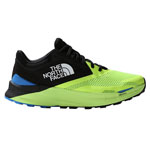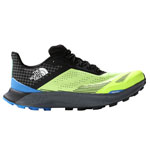Behind the name Vectiv 2.0 hides something more than a second version of an innovative product. It is the continuation of a technology that revolutionized trail running (it was the first carbon plate in footwear for this discipline) and The North Face continues to demonstrate how far this progress can go. We’re here to show you.

Vectiv 2.0, back and continuing to surprise. Photo - The North Face
As people who are passionate about outdoor products, we are excited to see how brands are constantly updating their products and technologies. Sometimes the motivation for these changes is to discover that there were situations of use not foreseen in the original design and, unfortunately, sometimes there are bugs that went unnoticed in the tests and should be corrected as soon as the opportunity arises.
However, with the release of the Vectiv 2.0 we discovered with great pleasure that this second version is related only to improvements in the efficiency of a product already designed to make the most of the energy invested in each step. Don't know what we are talking about? Here is a brief summary.
Studies carried out for years by all kinds of organizations and institutions, from sports brands to high performance centers and laboratories, have concluded that a large part of the energy exerted during running is lost at the moment of foot contact with the ground. The support against the ground and the cushioning provided by the footwear necessarily absorbs the impact suffered, but at the same time dissipates part of the energy we have put into the stride. How to design a shoe that optimizes this movement so that energy loss is minimized while cushioning and comfort are not compromised has been the subject of many hours of research by athletes and researchers.
And it seems that The North Face has hit the nail on the head. In 2021, the American brand announced, to the delight of athletes and retailers, the release of the first trail running shoe with a carbon plate, the Flight Vectiv. It is true that carbon plates had already been in the sports footwear market for some time, especially in track races, but also in mountaineering and expedition footwear, but the merit of The North Face was to adapt to the needs of trail running the advantages of an impact barrier, stability and momentum of existing plates with a three-dimensional design that broke with all the above and significantly improved stride efficiency.

A carbon plate and profile designed down to the millimeter are some key features. Photo The North Face
And not only that. Other details, such as the bi-density cushioning or the use of a spectacular sole with a flawless design and a grip that is still hard to believe today, have made the Flight Vectiv and the rest of the Vectiv range a surprise in the world of outdoor sports equipment from which we have not yet emerged.
This was what we had to remind you about what happened not too long ago. If you’d like to know more about Vectiv technology, you should have a look at the following article from our blog: “Vectiv Technology by The North Face”.
What's new with Vectiv 2.0?
The new features in Vectiv 2.0 are varied and interesting. In general we have to tell you that you should not expect a revolutionary change like the first version of Vectiv, but rather adaptations to new tests and to better respond to needs that were already covered by the first generation Vectiv, so that what you are going to see here is an improved product based on one that could already be considered as exceptional.
There are several models of shoes with Vectiv technology, each one with special characteristics that make them more suited for a certain type of running, which also depends on your running style and pace, personal needs and tastes. Below is a summary of the specific characteristics of each model and how they perform, so you can make the right choice for you.
You’ll find Vectiv 2.0 technology in the following shoes:
- Summit Vectiv Pro: made with a carbon plate in the midsole for long-lasting forward propulsion at the lightest possible weight.
- Summit Vectiv Sky: With a carbon plate and Pebax in the mid sole. Built for technical races, they are light and agile, though their main strength is the energy return in every stride.
- Summit Vectiv Enduris 3: with a TPU rock plate, offering the perfect balance between support and return.
- Vectiv Infinite 2: One of the most balanced trail running shoes between the stability they offer and the energy return they transmit after every stride. Internal double-density Pebax rock plate.
The main technical change of the second version, in addition to the look, is in the design of the carbon plate and the new geometry of the midsole, which we’ll discuss soon. We have here a range of shoes that have inherited the Vectiv technology that we already know, but which has been redesigned to further improve performance. More stability, better forward propulsion, greater cushioning, with an incredibly durable sweat-wicking upper.

A before and after in race performance and comfort. Photo - The North Face
Vectiv 2.0 Rock Plates
The new rock plates are an evolution of the original plates. The first carbon plate of Vectiv technology already had the advantage of a three-dimensional shape that, in addition to protecting very efficiently against irregularities in the terrain such as stones or branches, gave stability underfoot and provided good momentum.
Possibly the most obvious evolution of this part is in the new Vectiv 2.0 carbon plate included in the Summit Vectiv Pro model, which has a modified and improved design. It covers practically the entire sole of the shoe, from the heel to the toe, and has a forked design in the heel and forefoot, which allows it to work in solidarity with the midsole, providing stability and return not only from the center of the feet, but also on the sides. Precisely on the sides is where the shape that gives the enveloping structure to the carbon plate is located and allows maintaining great stability on technical terrain.

The redesigned 3D carbon plate provides even more race efficiency than the original
However, we mustn’t focus only the carbon fiber plates. In the Vectiv 2.0 range we also find plates made of Pebax and TPU depending on the model. The advantages of these midsole plates are well known: with the same tension generated in the flexion of the foot, they generate propulsion as they spring back into shape. This effect, although difficult to perceive in short races, represents significant energy savings in medium and long distance races, therefore it is an essential piece for energy efficiency in the race. The fact that it is made of carbon fiber means that this plate can be made of a material that is tremendously resistant as well as lightweight, thus allowing much thinner, less bulky and more lightweight designs without sacrificing durability.
Midsole
The midsole is another new feature. If we take as a reference the great cushioning of the Vectiv Enduris, The North Face Summit Vectiv Pro, new two seasons ago and characterized by its apparent and generous cushioning, has a cushioning four millimeters thicker than the Enduris.
This midsole is made entirely of foam from heel to toe. Typically, the midsole consists of foams of two different densities, one firmer to provide stability and firmness in the stride, while dissipating shock energy across the width of the structure, and the other softer and more reactive to absorb the impact of the stride, provide comfort and provide adequate momentum in the next step to complement the action of the carbon plate.

Highly pronounced rocker profile for an effective stride transition
The midsole rocker profile of all the Vectiv models is not a coincidence. If we were already surprised in 2021 by the sharp curve of the Vectiv shoes, this year with the Summit Vectiv Pro they have not been left behind. Comparatively, the toe is raised one centimeter compared to the models we already know and this is due to the fact that in the study of the running stride, the efficiency of this raised toe has been proven to provide an adequate impulse at the start of the stride and to allow more of the sole to be involved at that moment, improving grip and traction.
It may seem to those of us who are used to seeing many models of shoes that with this visible cushioning we are talking about a shoe with a high drop. Nothing could be further from the truth: the difference in height between the heel and midfoot results in a heel drop of six millimeters, so it can be considered a low-drop model despite its generous cushioning. Although it has the same heel drop as the Flight Vectiv, this is something to keep in mind for those who have not developed a great running technique or those who are used to training with very high heel drops in ultra-distance races.
Sole
The grip of the Surface Ctrl sole is impressive. As with all models of soles on the market, industrial secrecy is above customer information and it is impossible to know the "ingredients" of such a grippy compound, but it is worth testing them in difficult or extreme conditions (wet and polished rock with slope and at high speed) so that we can truly believe what we are experiencing.
It is not only in grip that this is a shoe that stands out. Its two different surfaces on the heel and on the rest of the shoe allow an exact differentiation between the propulsion and braking zones, so that compounds have been created that act in the most efficient way possible in any of the conditions that we put the shoe to test in.

Surface Ctrl sole – incredible grip
As in the previous versions, the 3.5 mm lugs strike a good balance between grip on soft terrain and good contact surface on rock to gain grip. We can affirm that both in the shape and opposite arrangement of the traction lugs with respect to the braking lugs and in the depth and spacing between them, the tread is produced in such a way that it adapts perfectly to the terrain, allowing the lugs to grip properly when the ground is soft (clay, mud, grass, snow ...) and maintaining the necessary grip while running across rocks.
Last and Upper
The width of the shoe is normally only specified on some models of running shoes and is a letter code (A, B, D and E) that is occasionally accompanied by a number on wide lasts. Thus for men the code is B (narrow), D (normal), 2E (wide) and 4E (extra wide) and for women it is A (narrow), B (normal), D (wide) and 2E (extra wide).
The North Face Summit Vectiv Pro uses a standard (D). This ensures a precise fit without constricting, giving a snug, enveloping feel, yet allowing for comfortable wear despite the expected expansion of the foot due to hours of running exertion and heat. This results in a comfortable shoe from the insole to the instep.
The upper is one of the parts that catches your eye when you first hold the shoes in your hand. The mesh that makes up the upper is tremendously open; we know that we are dealing with an extremely breathable shoe when we see the open weave that makes up its exterior. The thin threads of the fabric may give the appearance of weakness, but nothing could be further from the truth; it is a very resistant shoe that withstands friction and abrasion.
The shoe as a whole offers unbeatable performance for trail running: it is a model suitable for long distances and with excellent cushioning, but at the same time it is extremely light at 287 grams, with excellent grip and offers incredible reactivity thanks to its midsole profile and carbon plate.

Breathable upper with a comfortable, technical last for race day
In short, it is a model that will delight those who need the technicality of a shoe with the best technologies and design but do not want to give up the comfort offered by its studied structure and innovative materials. A great model that follows in the wake of its predecessors and to which we also predict the same success.
Online store: www.barrabes.com
















Leave a comment
Be the first to comment on this article.